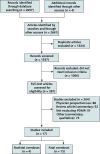Association Between Prescription Drug Monitoring Programs and Nonfatal and Fatal Drug Overdoses: A Systematic Review
- PMID: 29801093
- PMCID: PMC6015770
- DOI: 10.7326/M17-3074
Association Between Prescription Drug Monitoring Programs and Nonfatal and Fatal Drug Overdoses: A Systematic Review
Abstract
Background: Prescription drug monitoring programs (PDMPs) are a key component of the president's Prescription Drug Abuse Prevention Plan to prevent opioid overdoses in the United States.
Purpose: To examine whether PDMP implementation is associated with changes in nonfatal and fatal overdoses; identify features of programs differentially associated with those outcomes; and investigate any potential unintended consequences of the programs.
Data sources: Eligible publications from MEDLINE, Current Contents Connect (Clarivate Analytics), Science Citation Index (Clarivate Analytics), Social Sciences Citation Index (Clarivate Analytics), and ProQuest Dissertations indexed through 27 December 2017 and additional studies from reference lists.
Study selection: Observational studies (published in English) from U.S. states that examined an association between PDMP implementation and nonfatal or fatal overdoses.
Data extraction: 2 investigators independently extracted data from and rated the risk of bias (ROB) of studies by using established criteria. Consensus determinations involving all investigators were used to grade strength of evidence for each intervention.
Data synthesis: Of 2661 records, 17 articles met the inclusion criteria. These articles examined PDMP implementation only (n = 8), program features only (n = 2), PDMP implementation and program features (n = 5), PDMP implementation with mandated provider review combined with pain clinic laws (n = 1), and PDMP robustness (n = 1). Evidence from 3 studies was insufficient to draw conclusions regarding an association between PDMP implementation and nonfatal overdoses. Low-strength evidence from 10 studies suggested a reduction in fatal overdoses with PDMP implementation. Program features associated with a decrease in overdose deaths included mandatory provider review, provider authorization to access PDMP data, frequency of reports, and monitoring of nonscheduled drugs. Three of 6 studies found an increase in heroin overdoses after PDMP implementation.
Limitation: Few studies, high ROB, and heterogeneous analytic methods and outcome measurement.
Conclusion: Evidence that PDMP implementation either increases or decreases nonfatal or fatal overdoses is largely insufficient, as is evidence regarding positive associations between specific administrative features and successful programs. Some evidence showed unintended consequences. Research is needed to identify a set of "best practices" and complementary initiatives to address these consequences.
Primary funding source: National Institute on Drug Abuse and Bureau of Justice Assistance.
Conflict of interest statement
Figures
Comment in
-
Prescription Drug Monitoring Programs: Promising Practices in Need of Refinement.Ann Intern Med. 2018 Jun 5;168(11):826-827. doi: 10.7326/M18-0883. Epub 2018 May 8. Ann Intern Med. 2018. PMID: 29801101 No abstract available.
References
Publication types
MeSH terms
Grants and funding
LinkOut - more resources
Full Text Sources
Other Literature Sources
Medical
Miscellaneous


